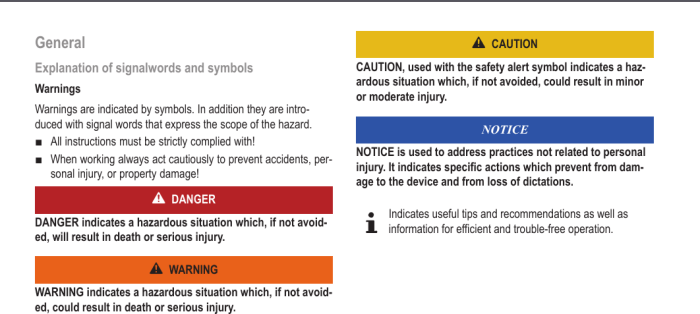In the realm of HA 2.1, warning and alert systems play a pivotal role in ensuring safety and optimizing efficiency. This article delves into the intricacies of HA 2.1 warning/alert symbols and controls, providing a comprehensive understanding of their purpose, functionality, and effective utilization.
HA 2.1 employs a diverse array of warning and alert symbols, each conveying a distinct message. These symbols serve as visual cues, alerting users to potential hazards, abnormal conditions, or critical information. Understanding their meaning and significance is essential for prompt and appropriate responses.
1. HA 2.1 Warning and Alert Symbols

HA 2.1 employs a comprehensive set of warning and alert symbols to convey critical information to users. These symbols are designed to alert users to potential hazards, system malfunctions, and other important events.
Each symbol is associated with a specific meaning and purpose. Understanding these symbols is crucial for ensuring the safe and efficient operation of HA 2.1 systems.
1.1 Symbol Overview
- Danger:Indicates an immediate and potentially life-threatening hazard.
- Warning:Indicates a potential hazard or unsafe condition.
- Caution:Indicates a potential problem or situation that requires attention.
- Notice:Provides important information that does not pose a hazard.
- Advisory:Offers guidance or recommendations for optimal system operation.
2. HA 2.1 Warning and Alert Controls
HA 2.1 offers a range of warning and alert controls to enable users to monitor and respond to system events. These controls provide flexibility and customization to meet specific operational needs.
The primary warning and alert controls include:
2.1 Audible Alerts, Ha 2.1 warning/alert symbols and controls
- Generate audible tones or messages to alert users to important events.
- Can be customized to suit specific environments and preferences.
2.2 Visual Alerts
- Display visual indicators such as flashing lights or color changes to attract attention.
- Provide clear and immediate feedback on system status.
2.3 Email and SMS Alerts
- Send notifications via email or SMS to inform users of critical events.
- Enable remote monitoring and response.
3. Configuration and Management of Warning and Alert Systems

Proper configuration and management of warning and alert systems are essential for ensuring their effectiveness and reliability. HA 2.1 provides comprehensive tools and options to customize and maintain these systems.
Key configuration and management tasks include:
3.1 System Setup
- Defining warning and alert thresholds
- Selecting appropriate alert mechanisms
- Configuring notification channels
3.2 Monitoring and Maintenance
- Regularly reviewing system logs
- Testing alert mechanisms
- Updating software and firmware
4. Troubleshooting Warning and Alert Systems
Despite careful configuration and management, warning and alert systems can occasionally encounter issues. Troubleshooting these issues is crucial for maintaining system reliability and safety.
Common troubleshooting steps include:
4.1 Verifying System Settings
- Confirming correct alert thresholds
- Ensuring proper selection of alert mechanisms
- Checking notification channel configurations
4.2 Testing System Functionality
- Manually triggering alerts to test response
- Verifying receipt of notifications
- Assessing system performance under various conditions
5. Case Studies and Examples

Practical examples and case studies provide valuable insights into the effective implementation and benefits of warning and alert systems in HA 2.1.
5.1 Case Study: Remote Monitoring of Critical Equipment
A manufacturing facility implemented a remote monitoring system using HA 2.1 to monitor critical equipment in real-time. The system generated email and SMS alerts when predefined thresholds were exceeded, enabling prompt intervention and minimizing downtime.
5.2 Example: Use of Audible Alerts in Healthcare
A hospital utilized HA 2.1’s audible alerts to notify staff of critical patient events. The alerts were customized to different levels of urgency, ensuring timely and appropriate response.
FAQ Insights: Ha 2.1 Warning/alert Symbols And Controls
What is the purpose of warning and alert symbols in HA 2.1?
Warning and alert symbols provide visual cues to users, indicating potential hazards, abnormal conditions, or critical information, enabling prompt and appropriate responses.
How do I identify and interpret HA 2.1 warning and alert symbols?
Each symbol conveys a specific message. Refer to the HA 2.1 documentation or consult with a qualified professional for accurate interpretation.
What are the different types of warning and alert controls available in HA 2.1?
HA 2.1 offers a range of controls, including audible alarms, visual indicators, and tactile feedback, allowing users to customize the system to meet their specific needs.
How can I effectively use warning and alert controls in HA 2.1?
Configure controls based on criticality and response requirements. Ensure clear communication channels and establish response protocols for each type of alert.
What are the best practices for configuring and managing warning and alert systems in HA 2.1?
Follow HA 2.1 guidelines, consider redundancy and failover mechanisms, and regularly review and update configurations to maintain system effectiveness.